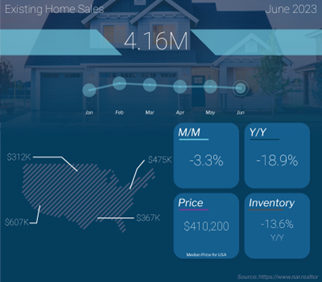
Existing Home Sales rose 0.2% from April to May to a 4.30-million-unit annualized pace, per the National Association of REALTORS® (NAR). However, sales were 20.4% lower than they were in May of last year. This report measures closings on existing homes, which represent around 90% of the market, making it a critical gauge for taking the pulse of the housing sector.
What’s the bottom line? Tight supply played a key role in the pace of sales, per NAR’s Chief Economist Lawrence Yun, who noted that, “Newly constructed homes are selling at a pace reminiscent of pre-pandemic times because of abundant inventory in that sector. However, existing-home sales activity is down sizably due to the current supply being roughly half the level of 2019.”
In fact, total existing housing inventory at the end of May equaled 1.08 million homes, well below normal with just 3 months’ supply available at the current sales pace.
Despite ongoing tight supply, demand among buyers remains strong as evidenced by how quickly correctly priced homes are selling. Homes stayed on the market on average for 18 days last month, down from 22 days in April. Plus, 74% of homes sold in May were on the market for less than a month, which is up from 73% in April and 65% in March.
Also of note, the median existing home price fell 3.1% to $396,100 from a year earlier, though does not mean home prices are declining. The median home price simply means half the homes sold were above that price and half were below it, and this figure can be skewed by the mix of sales among lower-priced and higher-priced homes. Actual appreciation numbers are higher, not lower, on a year-over-year basis and are showing acceleration according to key reports from Case-Shiller, CoreLogic and the Federal Housing Finance Agency.